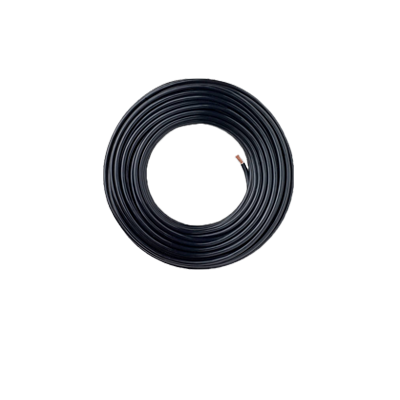Call +(254) 703 030 000 / 751 483 999 / 721 704 777
- Home
- Electrical
- Cables Conductors
- Copper Cables
- Single Core Electric Cables Housewiring
.....Read More
Frequently Asked Questions
What is a single core electric cable?
A single core electric cable is a type of electrical cable that consists of one conductor, typically made of copper or aluminum, surrounded by an insulating material. This conductor is responsible for carrying electrical current from one point to another. The insulation, often made from materials like PVC, rubber, or XLPE (cross-linked polyethylene), provides protection against electrical leakage, physical damage, and environmental factors such as moisture and chemicals.
Single core cables are commonly used in applications where a straightforward, uncomplicated connection is required. They are often employed in internal wiring of electrical devices, control panels, and distribution boards. These cables are also used in automotive wiring, solar panel installations, and other situations where space is limited and flexibility is needed.
The design of a single core cable allows for easy installation and maintenance. Its simplicity makes it cost-effective and efficient for transmitting power over short distances. However, for longer distances or higher power requirements, multi-core cables or cables with larger cross-sectional areas might be more appropriate to reduce voltage drop and power loss.
Single core cables are available in various sizes and ratings to suit different electrical loads and applications. The choice of cable depends on factors such as the current-carrying capacity, voltage rating, environmental conditions, and specific application requirements. Proper selection and installation are crucial to ensure safety, reliability, and compliance with electrical standards and regulations.
What materials are used for the conductor in single core cables?
Single core cables typically use copper or aluminum as the conductor material.
Copper is the most common choice due to its excellent electrical conductivity, which allows for efficient transmission of electricity with minimal energy loss. It also has good tensile strength, flexibility, and resistance to corrosion, making it suitable for various applications. Copper conductors are often used in residential, commercial, and industrial wiring.
Aluminum is another popular conductor material, especially in applications where weight and cost are significant considerations. Although it has lower electrical conductivity compared to copper, aluminum is lighter and less expensive. To compensate for its lower conductivity, aluminum conductors are usually larger in diameter than copper conductors for the same current-carrying capacity. Aluminum is often used in overhead power lines and in situations where weight reduction is crucial.
Both copper and aluminum conductors may be used in solid or stranded form. Solid conductors consist of a single wire, providing rigidity and ease of installation in fixed positions. Stranded conductors, made of multiple smaller wires twisted together, offer greater flexibility and are used in applications requiring frequent movement or vibration.
In some specialized applications, other materials like silver or gold may be used due to their superior conductivity and resistance to oxidation, but these are rare and typically reserved for high-performance or high-reliability applications due to their cost.
Overall, the choice of conductor material in single core cables depends on factors such as electrical performance requirements, cost, weight, and environmental conditions.
What types of insulation are used for single core cables?
The types of insulation used for single core cables include:
1. **Polyvinyl Chloride (PVC):** Commonly used due to its cost-effectiveness, flexibility, and resistance to moisture and chemicals. Suitable for low and medium voltage applications.
2. **Cross-Linked Polyethylene (XLPE):** Offers excellent thermal and mechanical properties, making it ideal for high voltage applications. It has a higher temperature rating and better resistance to environmental stress cracking.
3. **Ethylene Propylene Rubber (EPR):** Known for its excellent thermal stability and flexibility. It is used in medium to high voltage applications and provides good resistance to water and chemicals.
4. **Silicone Rubber:** Provides excellent thermal resistance and flexibility at both high and low temperatures. It is used in environments with extreme temperature variations.
5. **Neoprene:** Offers good resistance to oil, chemicals, and weathering. It is used in industrial applications where exposure to harsh conditions is expected.
6. **Low Smoke Zero Halogen (LSZH):** Emits minimal smoke and no halogenated gases when exposed to fire, making it suitable for use in confined spaces like tunnels and buildings.
7. **Paper Insulation:** Used in older installations, it is impregnated with oil or other substances to enhance its insulating properties. It is less common today due to advancements in synthetic materials.
8. **Fluoropolymer (e.g., PTFE, FEP):** Provides excellent chemical resistance and high-temperature performance. Used in specialized applications requiring high performance.
9. **Polyethylene (PE):** Offers good electrical properties and moisture resistance, commonly used in outdoor and underground cables.
10. **Rubber Insulation:** Includes various types like natural rubber and synthetic rubbers, providing flexibility and resistance to abrasion and impact.
Each type of insulation is chosen based on the specific requirements of the application, including voltage level, environmental conditions, and mechanical stresses.
How do you choose the right size of single core cable for house wiring?
To choose the right size of single core cable for house wiring, consider the following factors:
1. **Load Calculation**: Determine the total electrical load by adding up the wattage of all appliances and devices that will be connected to the circuit. This helps in calculating the current (in amperes) using the formula: Current (I) = Power (P) / Voltage (V).
2. **Current Carrying Capacity**: Select a cable that can handle the calculated current. Refer to standard cable rating charts to find the appropriate cable size that can safely carry the load without overheating.
3. **Voltage Drop**: Ensure the voltage drop across the cable length is within acceptable limits (typically less than 3-5%). Use the formula: Voltage Drop (Vd) = (Current (I) x Length (L) x Resistance (R)) / 1000. Choose a larger cable size if the voltage drop is too high.
4. **Cable Length**: Longer cable runs may require a larger cable size to minimize voltage drop and maintain efficiency.
5. **Ambient Temperature**: Consider the installation environment. Higher ambient temperatures can reduce a cable's current carrying capacity, necessitating a larger size.
6. **Installation Conditions**: Consider whether the cable will be installed in conduits, buried underground, or exposed to air. Different conditions affect heat dissipation and may require adjustments in cable size.
7. **Safety Standards and Regulations**: Adhere to local electrical codes and standards, which may specify minimum cable sizes for different applications.
8. **Future Expansion**: Consider potential future increases in load. Opting for a slightly larger cable size can accommodate additional load without needing rewiring.
9. **Material**: Choose between copper or aluminum cables. Copper has better conductivity, allowing for smaller sizes compared to aluminum for the same current capacity.
By considering these factors, you can select the appropriate cable size that ensures safety, efficiency, and compliance with regulations.
What are the advantages of using single core cables in house wiring?
1. **Simplicity in Installation**: Single core cables are straightforward to install due to their simple structure, making them ideal for straightforward wiring tasks in residential settings.
2. **Flexibility**: These cables are highly flexible, allowing for easy routing through walls, ceilings, and conduits, which is beneficial in complex wiring layouts.
3. **Cost-Effective**: Single core cables are generally less expensive than multi-core cables, making them a cost-effective choice for house wiring projects.
4. **Ease of Maintenance**: With single core cables, identifying and isolating faults is simpler, which facilitates easier maintenance and repair.
5. **Reduced Risk of Short Circuits**: The separation of individual conductors reduces the risk of short circuits, enhancing safety in household electrical systems.
6. **Better Heat Dissipation**: Single core cables can dissipate heat more effectively, reducing the risk of overheating and potential fire hazards.
7. **Customizability**: They allow for greater customization in wiring configurations, as each core can be individually routed and connected as needed.
8. **Improved Electrical Performance**: Single core cables often have lower resistance and better conductivity, which can improve the overall efficiency of the electrical system.
9. **Durability**: These cables are robust and less prone to damage from bending or twisting, ensuring a longer lifespan in residential applications.
10. **Compliance with Standards**: Single core cables often meet various electrical standards and regulations, ensuring safety and reliability in house wiring.
11. **Versatility**: They are suitable for a wide range of applications, from lighting circuits to power outlets, providing versatility in residential wiring solutions.
How do you install single core cables safely?
1. **Planning and Preparation**: Assess the installation site and plan the cable route. Ensure compliance with local electrical codes and standards. Gather necessary tools and personal protective equipment (PPE).
2. **Cable Selection**: Choose the appropriate single core cable based on current-carrying capacity, voltage rating, and environmental conditions.
3. **Safety Precautions**: De-energize the circuit where the cable will be installed. Use lockout/tagout procedures to ensure safety.
4. **Cable Handling**: Handle cables carefully to avoid damage. Use cable rollers or jacks to support heavy cables during installation.
5. **Route Clearance**: Clear the cable route of any obstructions. Ensure the path is free from sharp edges or surfaces that could damage the cable.
6. **Conduit Installation**: If required, install conduits or trunking to protect the cable. Ensure conduits are properly secured and grounded.
7. **Cable Pulling**: Use appropriate pulling techniques to avoid excessive tension. Employ cable lubricants if necessary to reduce friction.
8. **Bending Radius**: Adhere to the minimum bending radius specified by the manufacturer to prevent damage to the cable.
9. **Securing the Cable**: Use cable ties, clips, or clamps to secure the cable at regular intervals. Ensure the cable is not under tension or stress.
10. **Termination**: Strip the cable ends carefully and terminate using suitable connectors or lugs. Ensure connections are tight and secure.
11. **Earthing**: Properly earth the cable to prevent electrical hazards.
12. **Testing**: Conduct insulation resistance and continuity tests to verify the integrity of the installation.
13. **Documentation**: Record the installation details, including cable type, route, and test results for future reference.
14. **Final Inspection**: Perform a thorough inspection to ensure compliance with safety standards and rectify any issues before energizing the circuit.
What are the electrical standards for single core cables in residential buildings?
The electrical standards for single core cables in residential buildings typically adhere to national and international regulations to ensure safety and efficiency. These standards cover various aspects such as voltage rating, insulation type, conductor material, and installation practices.
1. **Voltage Rating**: Single core cables in residential settings are usually rated for low voltage applications, typically up to 600/1000V. This ensures they are suitable for household electrical systems.
2. **Conductor Material**: Copper is the preferred conductor material due to its excellent conductivity and flexibility. Aluminum may also be used but is less common in residential settings.
3. **Insulation Type**: The insulation material is crucial for safety and performance. Common insulation types include PVC (Polyvinyl Chloride), XLPE (Cross-Linked Polyethylene), and LSF (Low Smoke and Fume) materials. These insulations provide protection against electrical leakage, mechanical damage, and environmental factors.
4. **Current Carrying Capacity**: The cable's current carrying capacity must align with the expected load to prevent overheating. This is determined by the cable's cross-sectional area, insulation type, and installation conditions.
5. **Color Coding**: Standards often specify color codes for insulation to identify the cable's function (e.g., live, neutral, earth). This aids in safe installation and maintenance.
6. **Installation Standards**: Cables must be installed according to local building codes, which may dictate routing, support, and protection measures. This includes avoiding sharp bends, ensuring adequate spacing, and using appropriate conduits or trunking.
7. **Compliance and Testing**: Cables should comply with standards such as IEC 60227 or BS 6004, and undergo testing for properties like insulation resistance, dielectric strength, and flame retardance.
These standards ensure that single core cables in residential buildings are safe, reliable, and efficient, minimizing risks of electrical hazards.

